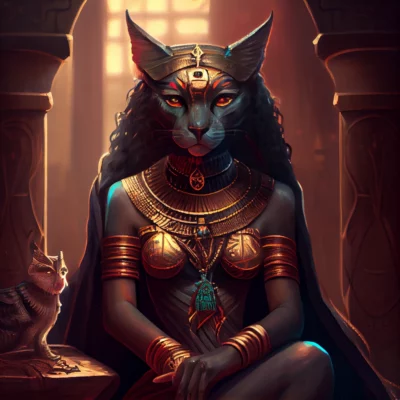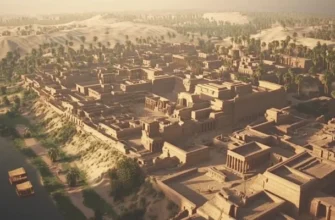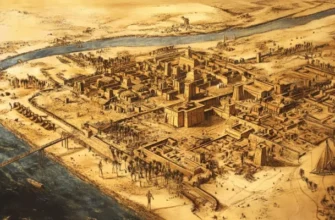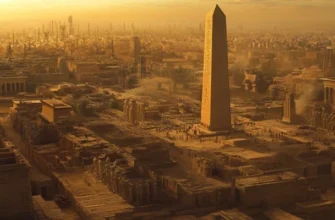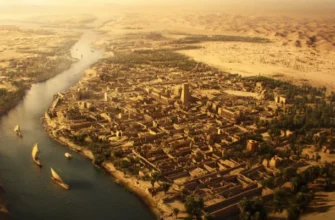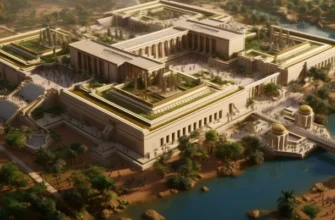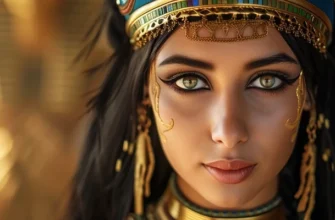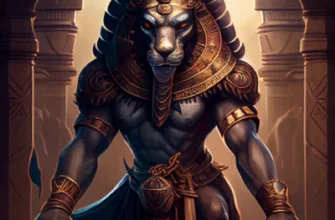The Egyptian goddess Bast is a goddess who was depicted as a cat. She symbolized harmony, beauty, and feminine energy. Bast was popular among pharaohs and ordinary people who revered her as a guardian of pets. In ancient Egyptian mythology, Bast was the daughter of the god Ra and protected the pharaohs. Many different objects, including amulets, talismans, and statuettes, were created in honor of Bast. In addition, there was a large temple of Bast in the city of Bubastis (modern Tell Basta in Egypt), which became one of the most famous shrines in Ancient Egypt. In our time, Bast continues to be an interesting object of research and study, and her image is found in many cultures and art.
- History of Bast
- Symbolism of Bast
- Bast’s life story
- Early years
- Legends of Bast
- Symbolism of Bast
- The symbol of the cat
- Symbol of harmony
- Symbol of feminine energy
- Images of Bast
- The cult of Bast in Ancient Egypt
- Bast’s role in religion
- Bast holidays and rituals
- Bast shrines
- Worship of Bast in modern times
- Worship in Egypt and around the world
- The role of Bast in modern culture
- Conclusion
History of Bast
The Egyptian goddess Bast was considered one of the most revered goddesses in ancient Egypt. Her beginnings date back to the Middle Kingdom, although much information about Bast dates back to the New Kingdom. She was the daughter of the god Ra and was born from his tears. Bast became popular among pharaohs and ordinary people who revered her as a guardian of domestic animals.
In ancient Egypt, Bast was often depicted as a cat or a woman with a cat’s head. The legends associated with Bast told of her power and protective properties, which proved useful for pharaohs and people in the fight against enemies.
Bast was originally the holy goddess of the city of Bubastis, but later her cult became popular throughout Egypt. Over time, Bast became synonymous with maternal love and the protection of pets. Many different objects, including amulets, talismans, and statuettes, were created in honor of Bast and her symbolism.
Symbolism of Bast
Bast, the Egyptian goddess, had a rich symbolism in ancient Egyptian mythology. She was depicted as a cat, a woman with a cat’s head, or a lion. Her symbols were candles, a lyre, a tambourine, a cat, a violet, and a lion. Cats were an important symbol of Bast, as they were her messengers on earth.
Bast was also a symbol of harmony, peace and prosperity. She protected people from diseases, harmful creatures, and accidents. Many of her images had to do with protection, including her depictions with flowers hugging her legs or sitting on her lap.
Additionally, Bast is known for her sanctity in relation to motherhood and children, so she was also depicted with children in her arms. Her name literally means “those she loves,” which may explain why she was revered as a patroness of the family and protector of children.
Bast’s life story
Bast’s life story in ancient Egyptian mythology is associated with her role as a goddess of protection and patroness. She was one of the most revered goddesses in Egypt, with a special cult in the city of Bubastis.
According to mythology, Bast was the daughter of the sun Ra and the sister of the god Mont. Her birth was associated with the creation of the world. She was also closely related to the moon god Khonsu, her twin brother.
Bast was the patroness of women and their fertility, and she was often depicted with children. She was also the protector of the home, family, and the city of Bubastis, where she had her main temple.
Myths associated with Bast stated that she was able to change her form into a lion to protect her worshippers from threats and evil forces.
Her cult persisted for many centuries, and Bast was considered one of the most important goddesses in ancient Egyptian mythology. She also experienced popularity in other cultures, including Greek and Roman mythology, where she was identified with the goddess Artemis.
Early years
According to ancient Egyptian mythology, Bast was born as the daughter of the sun Ra. She was one of the most ancient goddesses in Egypt, but her role in mythology gradually evolved over time.
In early mythology, Bast was associated with the world of death and the afterlife. She was often depicted as a lioness guarding the entrance to the underworld and protecting the souls of the dead.
Over time, her symbolism evolved to become the patroness of women, childbirth, and family happiness. Bast was also considered the protector of the city of Bubastis and its inhabitants.
In the myths associated with Bast, she was depicted as a powerful goddess who could change her form into a lion to protect her worshippers from dangers and evil forces. She was also associated with the moon and nighttime.
Her cult developed in the city of Bubastis, where she had her main temple, and spread throughout Egypt. Bast retained her popularity for many centuries, becoming one of the most revered goddesses in ancient Egyptian mythology.
Legends of Bast
Bast has many legends and myths related to her life and symbolism. One such legend tells how Bast became the patroness of the city of Bubastis.
According to this legend, the ancient Egyptian god Ra sent Bast to the city to stop the violence and crime that was taking place there. Bast arrived in the city in the form of a lioness and forced the criminals to retreat. Since then, Bast has become the patron saint of the city and its inhabitants.
Another legend relates how Bast became the patron saint of families and children. According to this legend, Bast began to protest against the way the father gods treated their children. She began to interact with mothers who asked for protection from their husbands. This led to Bast becoming the patroness of motherhood and family happiness.
In other myths, Bast is depicted as the moon’s companion, causing evil spirits to retreat and protecting her worshippers from them. She was also depicted as a young woman with the head of a cat, which symbolized her protective power.
These legends and myths helped to form the image of Bast as a powerful and protective goddess who occupies an important place in ancient Egyptian mythology.
Symbolism of Bast
The symbolism of Bast includes a variety of attributes and images that give her special meaning and power. The main symbols of Bast are:
The cat’s head – this symbol is associated with the protective power and ability of Bast to protect her fans from dangers.
A grid – this symbol is associated with the city of Bubastis, which was the patronage of Bast.
Sun – Bast was also associated with the sun and its life-giving power.
Pharaoh’s rod – this symbol is associated with the power and magic that Bast possessed.
Sometimes Bast was depicted as a lioness, which also symbolized her protective power and might.
Bast was also associated with music, dance, and joy, so she was depicted with musical instruments and as a dancer.
These symbols and images gave Bast a special significance for the ancient Egyptian believers and helped them focus on her power and protective force.
The symbol of the cat
The cat symbol played a very important role in the history of Bast. Cats were sacred animals in ancient Egyptian mythology and were associated with various gods and goddesses. Cats had a special status, and they were considered the protectors of the home and family. Bast, as the Egyptian goddess of cats, had a cat’s head on a human body.
Bast’s cat symbol was associated with her protective power and ability to protect her worshippers from dangers. The cat was also a symbol of anger, and Bast was known for her ability to be cruel when necessary. At the same time, cats were also associated with magic and energy, so Bast’s cat symbol also functioned as a magical amulet that attracted additional power and protection to its owner.
Symbol of harmony
Bast’s harmony symbol is associated with her ability to resolve conflicts and bring peace and harmony. This symbol is associated with the idea that Bast can resolve any dispute or conflict, ensuring harmony and stability in the home and community.
In mythology, Bast was a goddess of peaceful affairs who fought against evil and hostility. She was considered the patroness of family happiness and motherhood. Bast is also known for her ability to heal, especially in the field of women’s health.
The symbol of harmony, Bast, is depicted as a sign consisting of two intersecting cat paws. This symbol has been used as an amulet to ensure peace and harmony in the family and community, as well as a means of protection against negative energy and evil.
Symbol of feminine energy
Bast’s feminine energy symbol is related to her aspect as the goddess of motherhood, fertility, and protection. She was considered the patron saint of women, especially pregnant women, and was considered one of the main deities called upon to protect them from negative forces and threats.
The symbol of female energy Bast is depicted as a female figure with a cat’s head, which can be decorated with various objects, such as the sun, moon, crystals, or other symbols associated with female energy and fertility.
This symbol has been used as an amulet to attract fertility, a mother’s love, and protection from negative energy. It also symbolizes the power of female intuition, wisdom and magic that Bast possessed.
Images of Bast
In Egyptian mythology, Bast was depicted as a woman with the head of a cat or lion, animal ears and a mustache, which symbolized her presence in two worlds – human and animal. Her images were often accompanied by other symbols, such as the sun, moon, stars, and an ear of wheat, indicating her power over various aspects of life.
Bast was often depicted wearing a gold or silver ring on her head, symbolizing her divinity and power over the celestial bodies. Sometimes she was depicted holding weapons, such as a bow and arrows, indicating her martial skills and ability to protect her followers from danger.
Depictions of Bast usually had aesthetic features that indicated her beauty and compassion. She was often depicted with a bundle of fish, symbolizing her ability to assist people in fishing and other maritime endeavors.
The cult of Bast in Ancient Egypt
The cult of Bast was widespread throughout Ancient Egypt, and it was of great importance among the population. Many temples were built in honor of Bast, and she was revered as a goddess of popular worship.
The city of Bubastis, located in the east of the Nile Delta, was home to the main shrine of Bast. Annual festivals were held here, during which various rites and religious ceremonies took place.
Bast was also the patron saint of girls and women, and her cult was associated with motherhood, fertility, and family well-being. She was also a protector of children and babies, and was often depicted as a nurse carrying small children in her arms.
Additionally, Bast was associated with health and healing, and she was revered as a goddess who could help cure a variety of illnesses. Her sanctuaries were often a gathering place for medicine men and doctors who provided care to those in need of medical attention.
In general, Bast was an important goddess who contributed to the development of various aspects of people’s lives in Ancient Egypt, such as culture, art, science, and technology. Her cult influenced many aspects of the life of the Egyptian people, and she remains one of the most famous deities in Egyptian mythology.
Bast’s role in religion
Bast played an important role in the religion of Ancient Egypt. Her cult was associated with health, fertility, and protection from negative influences.
As the goddess of motherhood and fertility, Bast was the patroness of women who were at different stages of pregnancy, including those who wanted to have a child. She also protected small children and babies from various dangers and protected the family home from evil spirits.
Bast also played the role of a protector against disease, and she was associated with health and healing. Her shrines were a gathering place for medicine men and doctors who provided medical care to those in need of treatment.
In her role as a deity, Bast was also associated with knowledge and wisdom. She was the protector of music, dance, poetry, and literature. Her cult influenced many aspects of the life of the Egyptian people, and she remains one of the most famous deities in Egyptian mythology.
Bast holidays and rituals
The festivals and rituals associated with Bast were an important part of the religious life of Ancient Egypt. Her priests and worshippers held various rites and ceremonies to honor the goddess and ask for her protection and blessings.
One of the most well-known festivals associated with Bast was the Bastet Festival, which took place in July or August. This holiday was dedicated to Bast and her role as a protector against evil spirits, and she was also considered the patroness of dance and music. Various ceremonies and rituals were held during the holiday, including various dances and musical performances.
Another well-known holiday associated with Bast was Navkratis, which took place in September. This holiday was dedicated to the final harvest and Bast was considered the patroness of agriculture and fertility. During the festival, various ceremonies and rituals were held to celebrate the harvest and to bless the future crops.
In addition, Bast was associated with many other festivals and rituals, including ceremonies for the dispatch of the dead and rituals related to health and healing. She was also present in many Egyptian rites and ceremonies, which indicates the important role she played in the religious life of Ancient Egypt.
Bast shrines
In Ancient Egypt, temples were considered to be Bast shrines, in particular, the Temple of Bast in Bubast. It was one of the largest temples in Egypt and contained many sculptures and paintings on the theme of Bast. Her images could also be found in many other temples throughout the country. In the temples of Bast, rituals and sacrifices were held in honor of the goddess, and her cult was revered as the patroness of pets and women. Some Bast shrines have survived to this day, but most have been destroyed by time and war.
Worship of Bast in modern times
Modern worship of Bast can be found in various forms not only in Egypt but also in many countries around the world. Many people consider Bast to be the patron saint of pets, particularly cats, and create shrines and amulets in her honor. Bast is also an object of research and discussion among historians, archaeologists, religious scholars, and people interested in ancient Egyptian culture.
Worship in Egypt and around the world
In Egypt, Bast is still worshipped as one of the most important deities. Her image can be seen in many temples and museums. Also, some people consider her the patron saint of cats and pets, and create shrines and amulets in her honor. In many countries around the world, particularly in the West, Bast has also become an object of study and veneration. Her image can be found in art, literature, and on various merchandise that have become popular among lovers of ancient Egyptian culture.
The role of Bast in modern culture
Bast is an important figure in contemporary pop culture, particularly in games, comics, and movies. She is an object of research and study among people interested in ancient Egyptian culture. Also, her image can be found on various products such as amulets, jewelry, and other items used as talismans. In addition, Bast is a popular object in the fantasy genre, where she is depicted as a powerful and strong goddess who protects her worshippers.
Conclusion
Bast played an important role in ancient Egyptian culture as the goddess of cats, fertility, home comfort, and harmony. Her symbolism was associated with feminine energy, cats, and music. Her cult was popular among the population, and she was revered as the patroness of cats, pets, and women. Bast had an influence on the religious and cultural traditions of Ancient Egypt, and her image can be found in many temples and museums, as well as on various artifacts. Her importance for modern culture is manifested in her popularity among lovers of ancient Egyptian culture and in her use as a symbol in various fields of art and pop culture. In general, the Bast is an important element of the cultural heritage of Ancient Egypt, which continues to interest and inspire people around the world.
